Let's look at the five best banking ETF offerings that investors should consider for their portfolios. If you are new to banking ETFs or have been investing in bank ETFs for a while, this article will provide helpful information about the best bank stock ETFs into which you should invest your money.
What are bank ETFs?
Bank Exchange-Traded Funds (ETFs) present a streamlined and efficient approach to investing in the banking sector, eliminating the need for individual stock selection. These funds compile numerous bank stocks into a single investment vehicle, enhancing industry-wide exposure and potentially minimizing associated risks. Bank ETFs are characterized by their passive management style, which typically involves tracking a specific index of bank stocks. This approach eliminates the need for active management intervention by a fund manager.
A unique aspect of bank ETFs is that they trade on major stock exchanges like individual stocks. This makes it easy to buy and sell them during trading hours. In addition, bank ETFs are praised for their transparency, which gives investors clear and easy-to-understand information about their holdings, tracked index and historical performance. This transparency is essential for enabling investors to make informed investment decisions.
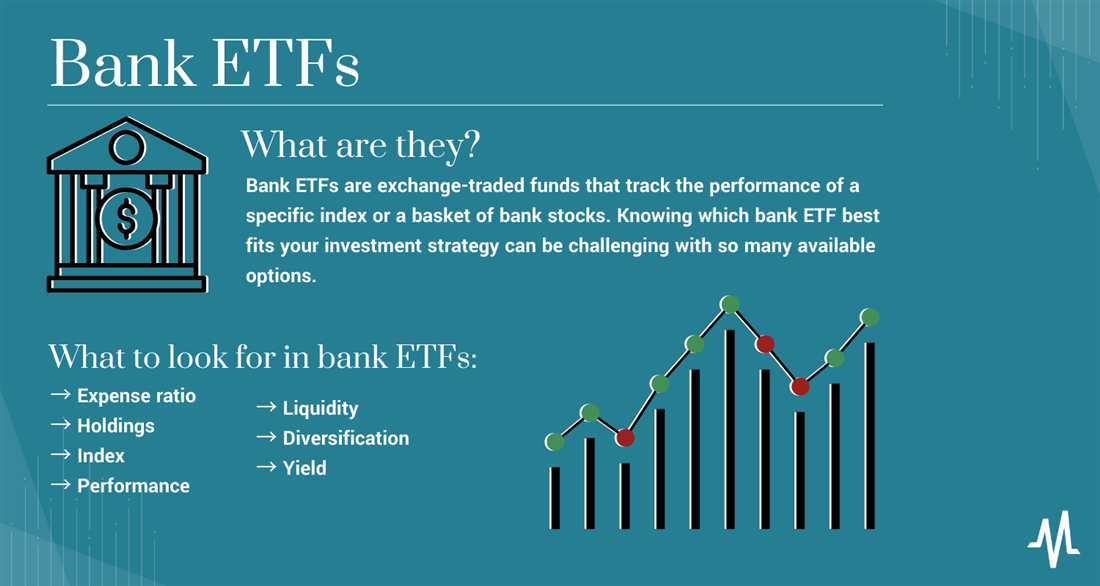
Key characteristics of bank ETFs
One of the primary advantages of bank ETFs is the diversification they offer. Investors gain exposure to an array of banks within a singular fund, effectively diluting the risks commonly associated with investments in individual bank stocks. In addition to diversification, bank ETFs are known for their comparatively low fees, especially when placed side by side against actively managed mutual funds. This cost-efficiency renders bank ETFs an appealing option for investing in the banking sector.
Another significant trait of these funds is their liquidity. Bank ETFs typically exhibit high trading volumes, ensuring investors can seamlessly execute on buy and sell orders without markedly affecting the share price. Additionally, these ETFs allow investors to target various segments within the banking industry. This includes options like large-cap, regional, or community banks, thereby aligning with diverse investment strategies.
Simplification and risk management
Bank ETFs offer you a simplified route to gaining sector exposure. This is particularly beneficial for those who prefer to avoid the complexities of researching and selecting individual bank stocks. Moreover, the inherent diversification within these ETFs serves as a buffer, mitigating the potential impact of losses from any single bank's underperformance.
The lower expense ratios of bank ETFs, relative to actively managed funds, can potentially enhance overall investment returns. Finally, the flexibility offered by these funds allows investors to tailor their market exposure according to their individual investment preferences and objectives, further underlining the appeal of bank ETFs in modern investment portfolios.
Types of bank ETFs
The extensive selection of bank ETFs spans from a regional to a global focus, catering to various investment strategies. This diversity is critical to customizing your investment approach to align with your financial goals and current market outlooks.
Regional vs. global focus
Regional bank ETFs concentrate on financial institutions within specific geographical areas. This focus allows investors to delve into the nuances of local economies, uncovering distinct opportunities that might be overlooked in broader national or international funds.
These ETFs often connect closely to regional market dynamics and may offer higher yields relative to their national or global counterparts, although they can also present increased geographic concentration risks. Notable examples include the SPDR S&P Regional Banking ETF NYSEARCA: KRE and the iShares Latin America Financials ETF NYSEARCA: ILF.
In contrast, global bank ETFs take a more expansive approach, encompassing financial institutions from multiple countries. This approach affords a higher level of diversification, reducing the impact of regional economic fluctuations on the portfolio. Global ETFs also allow investors to tap into the growth potential of emerging markets, which may offer higher growth prospects than mature markets. An example of this type of ETF is the iShares Global Financials ETF NYSEARCA: IXG.
Market-cap vs. equal weighted
The distinction between market-cap and equal-weighted ETFs introduces an extra layer of complexity to investment decision-making in the banking sector. Market-cap ETFs are structured to reflect the current market valuation, assigning greater weight to banks with higher market capitalization.
This structure often results in larger, more established banks significantly influencing the ETF's performance. Examples of market-cap ETFs include the Financial Select Sector SPDR Fund NYSEARCA: XLF and the iShares U.S. Financials ETF NYSEARCA: IYF.
In contrast, equal-weighted ETFs adopt a more egalitarian approach, allocating equal importance to each bank regardless of market size. This method provides potential exposure to smaller banks, which may have higher growth potential. However, this can also introduce greater volatility, given the more substantial impact of smaller company weightings on the ETF's performance.
Choosing the right bank ETF
Investors should carefully evaluate their investment objectives and risk tolerance when selecting between these diverse ETF types. Each option offers unique opportunities and challenges, significantly influencing one's journey in the banking investment sector. Whether the preference lies in exploring local economies or tapping into global financial trends, understanding these distinctions is critical in making informed investment decisions.
What to look for in bank ETFs
In uncertain economic times, many investors ask, "Are bank stocks safe?". A bank ETF can be an excellent way for investors to gain exposure to the banking industry while minimizing risk, and with the proper research, you can mitigate your stake in the banking sector. However, choosing the right bank ETF can be daunting, especially for those just starting to invest.
Consider several key factors when researching bank ETFs to make the process easier. Let's explore the most important things to look for expense ratio, holdings, index, performance, liquidity, diversification and yield. While we explore these variables, we will also show you how MarketBeat makes it a breeze to research bank index ETFs.
- Expense ratio: The expense ratio is the annual fee the fund charges investors for managing their money. Choosing a bank ETF with a low expense ratio is important to ensure you're not paying too much in fees. Every ETF listing on MarketBeat shows the expense ratio in the section at the top of the page.
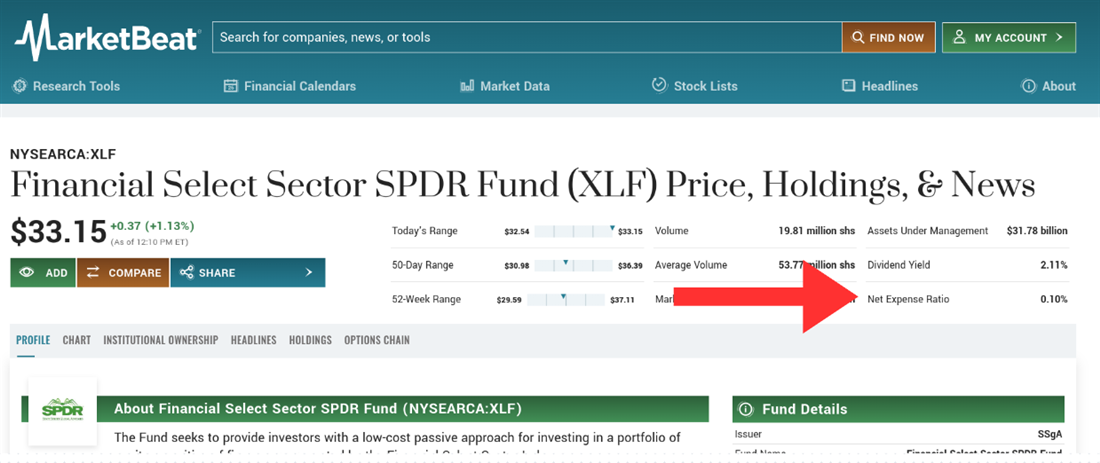
- Holdings: It's essential to look at the assets of the banking ETF to see what investments the ETF holds. Banking ETFs purchase and hold assets in banks and top financial services stocks. Reviewing the ETF's held assets will help you to determine whether the ETF aligns with your investment objectives and risk tolerance. This information is vital to check when researching any ETF, so it is in the top section of all MarketBeat ETF profiles. MarketBeat also lets you view ETF holdings individually via the holdings tab on each profile page.
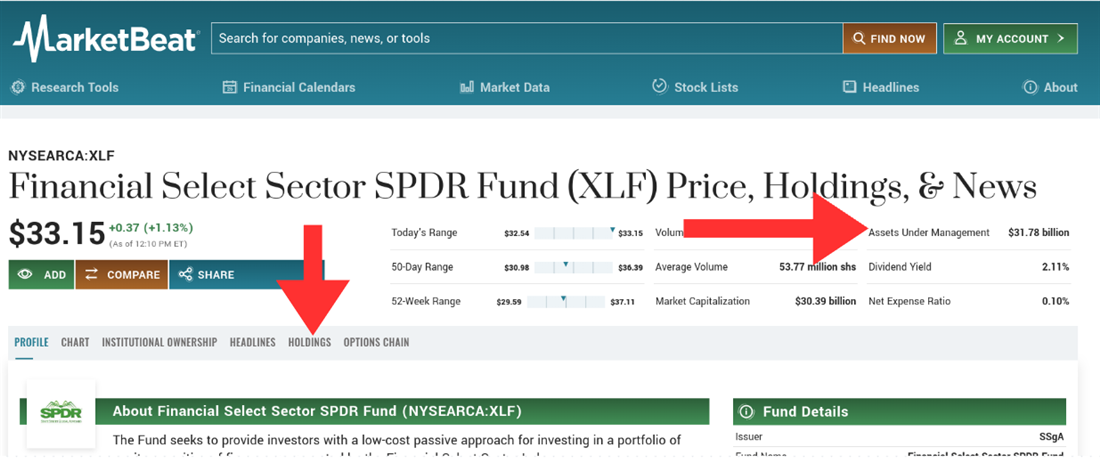
- Index: Bank ETFs track different indices, such as the S&P Bank Select Industry Index or the KBW Bank Index. Understand the index that the ETF tracks and whether it aligns with your investment strategy. This index sets a benchmark for the performance of the bank ETF, and its composition can vary depending on the index provider. For example, the S&P Bank Select Industry Index includes only U.S.-based banks, while the KBW Bank Index includes U.S. and non-U.S. banks. Investors should consider the index's composition when selecting a bank ETF, as it can affect the ETF's risk and return characteristics. Additionally, investors should consider the historical performance of the index and its correlation with their investment strategy to determine whether it's a suitable benchmark for their investment goals. MarketBeat tracks this information on the right side of each ETF profile in the "fund focus" section.
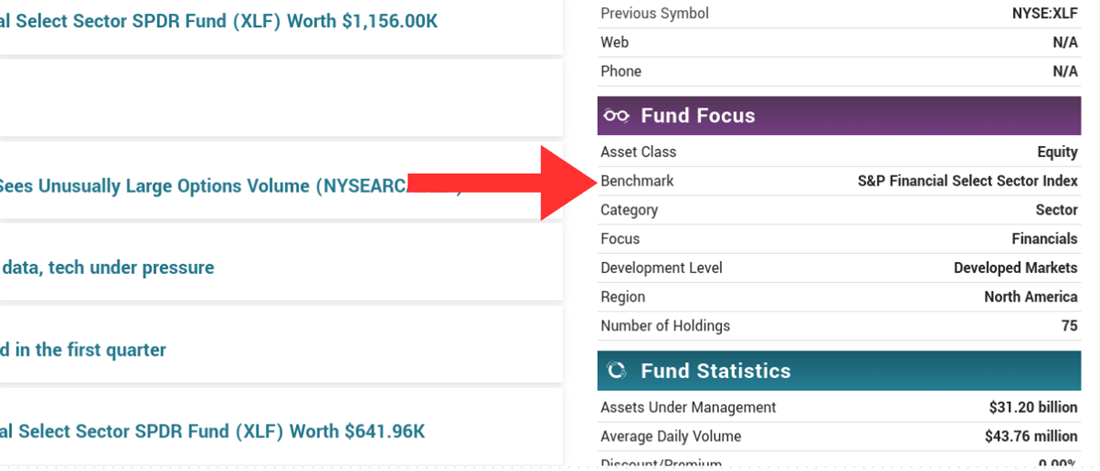
- Performance: It's essential to remember that past performance does not guarantee future performance, but it can provide valuable insight into how the bank's ETF has performed in different market conditions. To assess the performance of a bank ETF, investors can use various methods, such as comparing its performance to a benchmark index, analyzing its returns over different periods and evaluating its risk-adjusted performance. Additionally, investors should consider the fund's expense ratio and turnover rate, as these factors can affect the ETF's performance over the long term. By conducting thorough research and analysis, investors can better understand the bank ETF's historical performance and make informed investment decisions. You can easily compare bank stocks on MarketBeat using MarketBeat's curated bank stock comparison list. You can also compare stocks and ETFs on Marketbeat utilizing the comparison tool.
- Liquidity: When investing in a bank ETF, it's crucial to ensure that it has sufficient liquidity to buy and sell shares without causing significant price fluctuations. One way to check for liquidity in an ETF is to look at its trading volume, which you can find on MarketBeat in two ways. MarketBeat's profile header shows you the daily volume of stocks and ETFs. It also shows you the average daily volume for the stock, which can help you ascertain if the current daily volume is higher or lower than the average. High trading volume indicates that the ETF is actively traded, making buying or selling shares at the desired price easier. Investors can assess the liquidity of the ETF's holdings by looking at their trading volume and bid-ask spreads and by analyzing any regulatory filings or news articles related to the banks' liquidity. By conducting thorough research and analysis, investors can select a bank ETF with sufficient liquidity to meet their investment objectives.
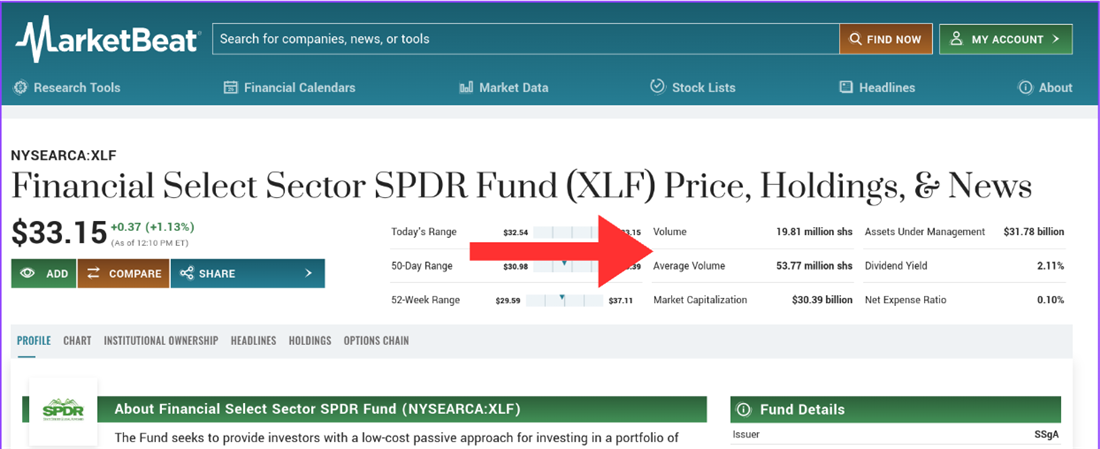
- Diversification: A well-diversified bank ETF will invest in multiple banks and geographies, reducing the risk of exposure to any one bank or region. We make checking for a stock or ETF's diversification easy by showing the top 10 financial holdings for each ETF, the sector exposure and the industry exposure about three-quarters of the way down on each MarketBeat ETF profile page.
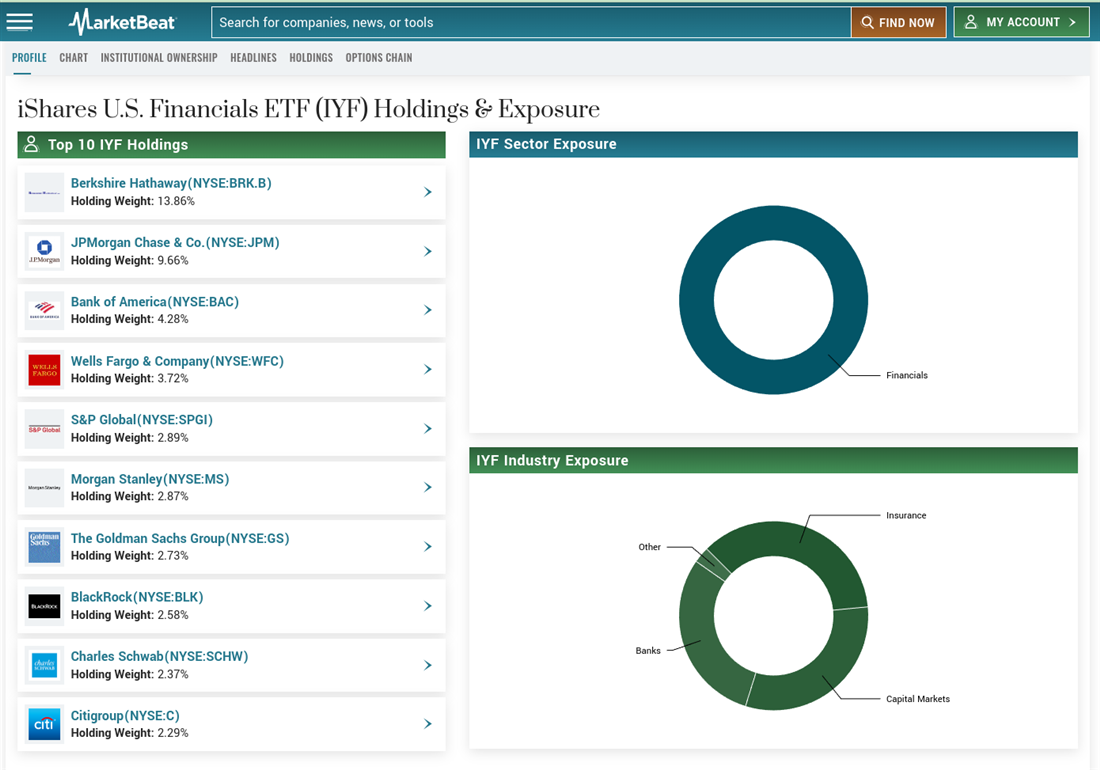
- Yield: Some bank ETFs may offer a yield, the income the underlying bank stocks generate. Understanding the yield and how it fits into your investment objectives is essential to creating a solid investment strategy. We provide the ETF's current yield at the top of each MarketBeat ETF profile page.
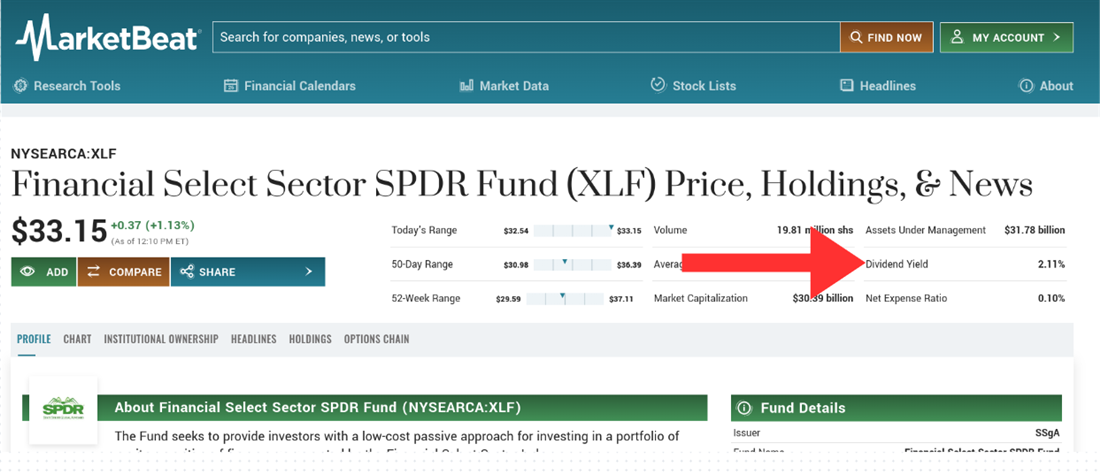
By considering these seven factors, investors can select a bank ETF that aligns with their investment objectives and provides a solid return on investment.
Five best bank ETFs to buy now
When investing in bank stocks, a bank ETF can provide a diversified and efficient way to gain exposure to this sector. However, with so many bank ETFs available, it can take time for investors to choose the best option for their portfolio. To help investors in this process, we have carefully researched and analyzed the market to identify what we consider to be the top five bank ETFs. Our selection is based on the factors discussed in the previous section. These five bank ETFs stand out as solid choices for investors seeking exposure to the banking sector while managing risk and maximizing returns.
Financial Select Sector SPDR Fund
The Financial Select Sector SPDR Fund NYSEARCA: XLF was launched in December 1998 and tracks the financial sector of the S&P 500 index, which tracks top finance stocks, including banks. It has an expense ratio of 0.10%, holds 75 assets and follows the S&P Financial Select Sector Index. The XLF financial ETF has had a strong performance recently, with an average return of around 5%. The fund has strong liquidity, with an average daily trading volume of approximately 53 million shares. The fund is well-diversified, focusing on large-cap companies and provides about a 2% yield to investors.
iShares U.S. Financials ETF
The iShares U.S. Financials ETF NYSEARCA: IYF launched in May 2000 and provides exposure to U.S. financial companies, including banks, focusing on large and mid-cap companies. It has an expense ratio of 0.39%, holds 143 assets and tracks the Dow Jones U.S. Financials Index. The ETF has performed well over the recent past, with an average return of around 13%. IYF has solid liquidity, with an average daily trading volume of approximately 188,000 shares. The fund is well-diversified and provides about a 1.6% yield to investors.
Invesco KBW Bank ETF
Invesco KBW Bank ETF NASDAQ: KBWB launched in November 2011 and tracks the KBW NASDAQ Bank Index, providing exposure to U.S. banking stocks. It has an expense ratio of 0.35%, holds 27 assets and tracks the KBW NASDAQ Bank Index. KBWB has had a strong performance recently, with an average return of around 10%. It has strong liquidity, with an average daily trading volume of over one million shares. The fund is less diversified than other bank ETFs, focusing on small- to mid-cap companies and provides over a 3% yield to investors.
SPDR S&P Regional Banking ETF
SPDR S&P Regional Banking ETF NYSEARCA: KRE was launched in June 2006 and tracks the performance of regional banks in the S&P Total Market Index, providing exposure to smaller banks. It has an expense ratio of 0.35%, holds 141 assets and tracks the S&P Regional Banks Select Industry Index.
KRE has had an average return of around 7%, and its liquidity is strong, with an average daily trading volume of about 19 million shares. The fund is well-diversified, focusing on small- to mid-cap companies and providing approximately a 2.8% yield to investors.
First Trust NASDAQ ABA Community Bank Index Fund NYSEARCA: QABA was launched in July 2009 and tracked the performance of small- and mid-cap banks in the U.S. that are members of the American Bankers Association. It has an expense ratio of 0.6%, holds 125 assets and tracks the NASDAQ OMX ABA Community Bank Index.
This index fund has had a strong performance over the past year, with a return of over 5%. The liquidity of QABA is moderate, with an average daily trading volume of approximately 30,000 shares. The fund is well-diversified, focusing on small- to mid-cap companies and yields roughly 2.7% to investors.
How to evaluate bank ETFs
When investing in bank ETFs, evaluating them can help you make informed decisions that align with your investment objectives and risk tolerance. By taking a comprehensive approach to assessing bank ETFs, you can increase your chances of selecting the right ETF for your portfolio. Let's discuss how to utilize the information discussed earlier to evaluate a bank ETF effectively.
Consider the expense ratio to evaluate a bank ETF, impacting your overall returns. It's essential to look for a low expense ratio to ensure you don't overpay in fees. The next step is to examine the ETF's holdings and the index it tracks to help you determine whether the ETF aligns with your investment objectives and risk tolerance. Consider evaluating the ETF's past performance, remembering that past performance does not guarantee future performance.
Additionally, look for sufficient liquidity, which ensures you can easily trade ETFs without causing significant price fluctuations. Diversification is also key, as a well-diversified bank ETF will invest in multiple banks and geographies, reducing the risk of exposure to any one bank or region. Lastly, consider the yield the bank ETF offers. By evaluating bank ETFs using these criteria, you can select an ETF that aligns with your investment objectives and provides a solid return on investment.
Selecting the right bank ETF
Selecting the right bank Exchange-Traded Fund (ETF) involves a process similar to choosing a dependable financial ally. This journey starts with understanding the essential criteria for making a prudent choice.
Criteria for evaluation
Selecting the right bank ETF is not a matter of chance but a calculated process guided by strategic evaluation. Let’s explore the key criteria that empower investors to make informed decisions and identify ETFs that align with their investment objectives.
The impact of expense ratios
A primary consideration in this selection process is the expense ratio. This figure represents the annual fee charged by the ETF and is a critical factor affecting long-term investment returns. A lower expense ratio means fewer costs are deducted from the fund, potentially resulting in more retained earnings for the investor. Thus, identifying ETFs with lower expense ratios is crucial for enhancing the profitability of an investment.
Understanding assets under management
Another vital aspect is the ETF's liquidity and stability, often indicated by its Assets Under Management (AUM). The AUM reflects the fund's size and its trading volume. ETFs with larger AUMs generally exhibit higher liquidity, facilitating smoother transactions when buying or selling shares. This attribute is essential for investors who value the ability to quickly and efficiently enter or exit positions.
The relevance of tracking error
The tracking error is a measure that evaluates how closely an ETF follows its underlying index. A lower tracking error implies a closer alignment with the targeted market segment, indicating the ETF's effectiveness in replicating the index's performance. Investors should seek ETFs with minimal tracking errors to represent their desired market exposure accurately.
Aligning with investment goals
After establishing a foundation of cost-effective and stable options, investors should explore the ETF's specific features more deeply. Key considerations include:
- Market capitalization focus: Different ETFs target various market capitalizations, such as broad market, large-cap, mid-cap, small-cap, or regional focuses. Each of these categories aligns with distinct risk profiles and growth potentials.
- Investment strategies: ETFs may be oriented towards growth, focus on dividends, or be driven by value. Investors should align the ETF's strategy with their investment objectives and desired returns.
- Index tracking: Different indices represent varied sector allocations and risk profiles. Thorough research into the underlying index is essential to ensure it aligns with your investment thesis.
Popular bank ETFs and their features
The bank ETF sector is very diverse. However, a handful of contenders consistently capture the attention of investors. Let’s take a look at the unique characteristics, showcasing their strengths and potential alignment with your investment goals.
Conducting comparative analysis
A structured comparative analysis is essential to find the most suitable Exchange-Traded Funds (ETFs) for your investment portfolio. This process entails evaluating each shortlisted ETF against a set of defined criteria, ensuring that the selected funds are aligned with your investment objectives and risk profile. These criteria include:
- Expense ratios: The expense ratio is the annual fee charged by an ETF to cover its operating expenses. This fee is typically expressed as a percentage of the ETF's net assets.
- AUM: The AUM, or assets under management, is the total value of an ETF's assets. This figure is often used as a proxy for the ETF's size and liquidity.
- Tracking error: The tracking error measures how closely an ETF tracks its benchmark index. A low tracking error indicates that the ETF is closely following its index, while a high tracking error suggests that the ETF is not closely tracking its index.
- Market capitalization focus: The market capitalization focus of an ETF refers to the size of the companies in which the ETF invests. ETFs can be focused on large-cap, mid-cap, small-cap, or a combination of these.
After analyzing these key components, the comparative analysis will serve as a guide, providing you with the best ETFs for inclusion in your portfolio. By carefully evaluating these criteria, you can identify funds that provide a well-balanced combination of cost-effectiveness, alignment with investment objectives and market relevance, making an informed and strategic addition to your investment portfolio.
The importance of diversification
Diversification remains a cornerstone of investment risk mitigation. Investors should consider allocating their investments across multiple ETFs with complementary characteristics. This strategy creates a well-rounded, diversified portfolio that aligns with the investor's financial objectives.
Current trends in bank ETFs
The bank ETF sector is dynamic and sometimes very volatile. This is created by constantly shifting investor sentiment and market forces. Navigating this volatility requires a keen eye for the banking sector's trends. Let’s take a look at some of the current trends in banking sector that could effect a banking ETF:
The evolution from passive to active management
The bank exchange-traded funds (ETFs) sector is evolving, with investor sentiment and market dynamics playing a role. A notable trend is the shift away from predominantly passive, index-tracking ETFs and toward actively managed bank ETFs. These actively managed funds use the expertise of financial professionals to select individual stocks with the goal of outperforming the market. This approach has become increasingly popular, particularly in volatile markets where the potential to generate alpha—exceeding the market average—is highly sought after.
The emergence of ESG in banking investments
Another pivotal trend is the integration of Environmental, Social and Governance (ESG) considerations into investment decisions. ESG factors are becoming increasingly important across all sectors, and bank ETFs are no exception. This shift reflects a growing investor emphasis on sustainable banking practices, driven by concerns over climate change, social responsibility and ethical corporate governance. Consequently, this trend paves the way for innovative ETFs targeting ESG themes within the banking sector.
The rise of niche-focused bank ETFs
The era of generic, one-size-fits-all bank ETFs is giving way to a demand for more specialized and tailored investment options. This shift is evident in the increasing number of niche ETFs that cater to distinct market segments such as regional banks, community banks, fintech and high-dividend bank stocks. This evolution allows investors to construct highly personalized portfolios that align with their specific risk tolerances and investment objectives.
Technological advancements reshaping investment strategies
The proliferation of robo-advisors and automated investment platforms is transforming the banking and investment landscape. These platforms frequently offer pre-configured ETF portfolios, including those focused on bank ETFs, broadening their appeal to a diverse investor base. This technological progression is expected to further stimulate the growth and diversification of bank ETFs as they become integral to automated investment strategies.
Leveraging data analytics for enhanced ETF selection
In today's data-driven investment environment, big data and advanced analytics are becoming critical tools for selecting ETFs. Investors increasingly utilize AI-powered analytics to evaluate performance data, risk profiles and market trends to pinpoint the most promising bank ETFs. This sophisticated, data-centric approach is revolutionizing how investors assess and select ETFs, adding a new dimension of insight to their investment strategies.
Navigating the dynamic bank ETF market
By staying abreast of these prevailing trends, investors can more adeptly navigate the ever-changing bank ETF landscape. It is essential to remember the importance of diversification, considering investments in multiple ETFs with complementary features to create a robust and balanced portfolio. Maintaining an informed and flexible investment strategy is key to capitalizing on emerging opportunities in the bank ETF sector as the market evolves.
Expert opinions on the future of bank ETFs
The bank ETF market's future is bright, with potential for growth and evolution. Industry experts and market predictions paint a positive picture of what lies ahead for this market sector.
Growth spurt ahead
According to analysts, several factors are expected to keep bank ETFs on an upward trajectory: rising interest rates, a growing financial sector and technological advancements. This surge in popularity is good news for investors looking to gain exposure to a dynamic and promising market segment.
The active vs. passive dance
While passive, index-tracking ETFs are likely to remain the bedrock of the market, experts foresee a more subtle future. Actively managed strategies are poised to play a larger role, potentially outperforming in specific market environments. Hybrid approaches blending the best of both worlds could also emerge, offering investors a more comprehensive range of choices.
Sustainability takes the helm
ESG considerations are rapidly becoming a non-negotiable factor for investors, and bank ETFs must adapt. Expect a surge in options focused on sustainable banking practices, appealing to a growing segment of ethically conscious investors. Thematic ETFs targeting specific ESG themes within the banking sector, like clean energy finance or community development banks, are also likely to gain traction.
Tech revolution reshapes the landscape
Robo-advisors and automated platforms will play a crucial role in democratizing access to bank ETFs, making them more accessible to a broader range of investors. We may even see the rise of decentralized ETF platforms leveraging blockchain technology to offer greater transparency and efficiency. You can also expect to see an increase in fintech companies and fintech ETFs.
Data-driven decisions rule the day
Big data and AI will become increasingly valuable tools for investors interested in exploring the bank ETF landscape. Expect data-driven platforms and tools to emerge, providing deeper insights into risk profiles, performance potential and sector trends, empowering investors to make informed decisions.
The future of bank ETFs promises robust growth, innovation and adaptation. From niche options catering to specific needs to the rise of hybrid strategies and cutting-edge technology, the landscape is set to evolve rapidly.
Tax considerations for bank ETF investments
While the alluring potential of bank ETFs is undeniable, understanding their tax implications is crucial for maximizing your returns.
Capital gains: Dancing with Uncle Sam
Selling ETF shares at a profit triggers capital gains tax, with rates varying depending on the holding period and income level. Holding bank ETFs for more than a year qualifies for long-term capital gains rates, often significantly lower than ordinary income tax rates. Short-term gains (holdings of less than one year) are taxed at your regular income tax rate.
Dividends: A sweet (but taxable) treat
Bank ETFs often distribute dividends, offering a steady stream of income. These dividends are generally taxed as ordinary income, albeit with certain exceptions for qualified dividends from U.S. corporations meeting specific criteria. Reinvesting dividends can compound your returns over time, potentially mitigating the immediate tax impact.
Tax-efficient strategies
Savvy investors can leverage various strategies to minimize their tax burden. Here are some options to consider:
- Maximizing tax-advantaged accounts: Invest in bank ETFs within IRAs or 401(k)s to grow your wealth tax-deferred or tax-free, depending on the account type.
- Tax-loss harvesting: Offset capital gains in your portfolio by selling bank ETFs at a loss, potentially lowering your taxable income.
- Focus on long-term investments: Prioritize bank ETFs you intend to hold for over a year to benefit from favorable long-term capital gains rates.
- Choose carefully: Compare expense ratios and underlying holdings across different bank ETFs to maximize returns and minimize unnecessary tax drags.
Banking on success: Our top picks for bank ETFs
Bank ETFs can expose investors to the banking sector without the risk of investing in individual stocks. Investors should consider factors such as expense ratio, holdings, index, performance, liquidity, diversification and yield when evaluating bank ETFs.
Our research and analysis has highlighted five top bank ETFs that investors may consider for their portfolios. Conduct your own research and due diligence before making any investment decisions. Overall, bank ETFs can be a valuable addition to a well-diversified portfolio. Consider your investment goals and risk tolerance before investing in any financial product.
FAQs
After exploring the best bank ETFs available on the market and how to evaluate them, you may still have some questions about investing in bank ETFs. In this section, we've compiled answers to some of the most common questions we've encountered in our research.
What is the best ETF for banks?
When considering the best bank ETF, it's important to remember that there is no one-size-fits-all answer. Your ideal ETF will depend on your investment goals, risk tolerance and personal preferences. Conduct thorough research and carefully evaluate each option to determine which aligns best with your needs. Consider the ETF's expense ratio, liquidity, holdings and performance history to make an informed decision.
Is there a bank index ETF?
Yes, there are bank index ETFs available. For example, the Invesco KBW Bank ETF (KBWB) tracks the KBW NASDAQ Bank Index, while the Financial Select Sector SPDR Fund (XLF) tracks financial companies in the S&P 500 index, including banks.
Does Vanguard have a bank ETF?
Before you consider Financial Select Sector SPDR Fund, you'll want to hear this.
MarketBeat keeps track of Wall Street's top-rated and best performing research analysts and the stocks they recommend to their clients on a daily basis. MarketBeat has identified the five stocks that top analysts are quietly whispering to their clients to buy now before the broader market catches on... and Financial Select Sector SPDR Fund wasn't on the list.
While Financial Select Sector SPDR Fund currently has a "Hold" rating among analysts, top-rated analysts believe these five stocks are better buys.